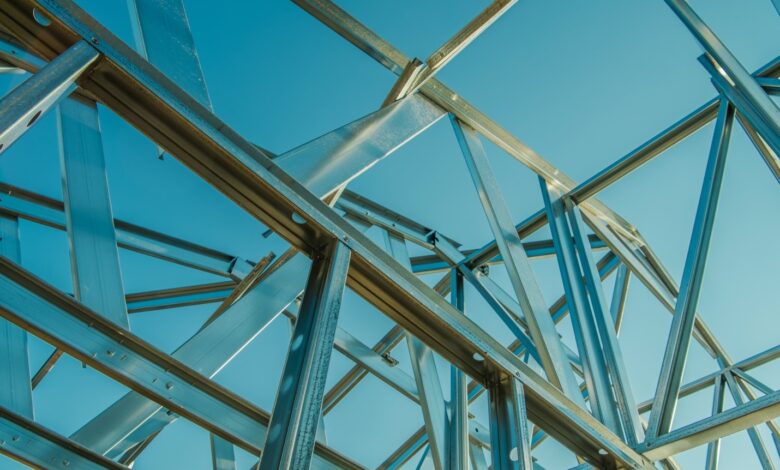Future of Structural Engineering

As the industry pushes for stronger buildings, longer lifespans, and greener construction methods, stainless steel is stepping up in new and exciting ways. Thanks to ongoing innovations in strength, sustainability, and corrosion resistance, stainless steel is becoming more than just a reliable option—it’s a smart, forward-thinking choice for the structures of tomorrow.
Smarter Strength for Modern Demands
Engineers today are being asked to deliver more—larger spans, lighter loads, and longer-lasting performance, all while managing tighter budgets and stricter sustainability goals. Advanced stainless steel alloys are helping meet those demands. Grades like duplex and martensitic stainless steel offer high tensile strength without the excessive weight, which allows for leaner structural components and greater design flexibility.
This matters in everything from super-tall skyscrapers to pedestrian bridges. Lightweight yet high-strength stainless components reduce dead loads and foundation requirements. That’s a big advantage in urban or geologically sensitive sites where traditional materials pose design limitations. These newer grades are also more formable, allowing architects to push the boundaries of design without sacrificing performance.
What About Corrosion?
Of course, performance isn’t just about strength—it’s also about how long materials last. One of the most common questions in structural planning is: does stainless steel rust? While it’s highly resistant, stainless steel isn’t completely immune to corrosion under all conditions. That said, when the right grade is chosen for the right environment, corrosion is a non-issue.
For example, 316 stainless steel is widely used in coastal infrastructure because of its strong resistance to salt and humidity. Duplex grades perform exceptionally well in chemical plants and wastewater facilities. The key is material selection—and that’s where suppliers like StainlessEurope play a critical role, offering technical support and material data that take the guesswork out of project planning.
Sustainability as Standard
Modern construction must meet environmental goals, and stainless steel fits naturally into that shift. Many of today’s mills use high-recycled-content steel, and the production process itself has become cleaner and more efficient over the past two decades. Stainless steel is also fully recyclable without loss of quality, making it a circular material that supports long-term sustainability targets.
Over a building’s lifecycle, stainless steel offers excellent value—not just in reduced maintenance, but in environmental performance. It requires less frequent replacement, resists wear in extreme conditions, and can be reused or recycled at the end of its service life. For projects aiming for LEED, BREEAM, or ESG goals, it’s a strong material choice—literally and ethically.
Smart Engineering: Stainless Gets Connected
Among the many new developments in this space, the ability to include smart monitoring technology in the demonstrated monitoring technology is one of the most exciting. As of now, this technology is being tested to include embedded sensors in stainless steel structural components that can register stress, strain, temperature changes, and even the earliest signs of corrosion. Taken together, these sensors can convert ordinarily passive building material into something more: a smart system that can alert engineers to growing structural problems before they need costly and time-consuming repairs.
Imagine a bridge that can tell you in real time when it’s starting to develop microcracks or a stadium roof that can measure the amount of stress it’s receiving from wind during a hurricane. These aren’t concepts for the future—they’re being implemented today. If your next building project requires any form of smart element, it stands to reason that stainless steel is going to be your best possible ally due to how innately durable and versatile it is.
How StainlessEurope Supports the Industry
Innovation doesn’t happen in isolation. Suppliers like StainlessEurope play a major role in making these advanced materials available and understandable. Their support ranges from sourcing high-performance alloys to providing project-specific guidance, helping engineers choose the right grade for structural loads, corrosion zones, and lifecycle goals.
They also keep pace with changing standards, sustainability metrics, and performance expectations—so that what gets built today still stands strong tomorrow. Whether it’s infrastructure, architecture, or industrial design, StainlessEurope is helping deliver the materials and knowledge that keep structures strong, safe, and future-ready.
Final Thoughts
The future of structural engineering is built on materials that are adaptable, resilient, and sustainable. Stainless steel—once thought of as purely decorative or limited to industrial applications—is now leading innovation across every sector of construction. With better corrosion resistance, smarter strength, and growing sustainability advantages, it’s redefining what’s possible in modern design.
As technology and expectations evolve, stainless steel continues to rise to the challenge—and with the right partners, engineers can shape a future that’s stronger, smarter, and built to last.





